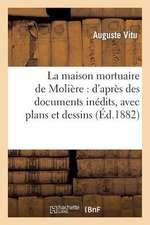The Visual Culture of Violence After the French Revolution
Autor Lela Graybillen Limba Engleză Hardback – 14 iul 2016
The Visual Culture of Violence after the French Revolution will be broadly relevant to scholars of art, media and visual studies, and particularly to historians of the French Revolution and eighteenth- and early nineteenth-century Europe. The book's concern with the representation of violence makes it of interest to scholars working in a variety of fields beyond its historical period, especially in art, literature, history, media and culture studies.
| Toate formatele și edițiile | Preț | Express |
|---|---|---|
| Paperback (1) | 258.70 lei 6-8 săpt. | |
| Taylor & Francis – 14 oct 2024 | 258.70 lei 6-8 săpt. | |
| Hardback (1) | 821.96 lei 6-8 săpt. | |
| Taylor & Francis – 14 iul 2016 | 821.96 lei 6-8 săpt. |
Preț: 821.96 lei
Preț vechi: 1179.33 lei
-30% Nou
Puncte Express: 1233
Preț estimativ în valută:
157.28€ • 164.21$ • 130.17£
157.28€ • 164.21$ • 130.17£
Carte tipărită la comandă
Livrare economică 05-19 aprilie
Preluare comenzi: 021 569.72.76
Specificații
ISBN-13: 9781472450197
ISBN-10: 1472450191
Pagini: 212
Dimensiuni: 156 x 234 x 16 mm
Greutate: 0.57 kg
Ediția:1
Editura: Taylor & Francis
Colecția Routledge
Locul publicării:Oxford, United Kingdom
ISBN-10: 1472450191
Pagini: 212
Dimensiuni: 156 x 234 x 16 mm
Greutate: 0.57 kg
Ediția:1
Editura: Taylor & Francis
Colecția Routledge
Locul publicării:Oxford, United Kingdom
Public țintă
AcademicCuprins
List of Illustrations
Acknowledgements
Introduction
1 The Guillotine in Perspective
2 The Limit Case: Philippe-Auguste Hennequin’s The Remorse of Orestes at the Salon of 1800
3 Technologies of Witness: Violent Spectacle and the Fualdès Affair
4 A Proximate Violence: Madame Tussaud’s Chamber of Horrors
Conclusion
Bibliography
Index
Acknowledgements
Introduction
1 The Guillotine in Perspective
2 The Limit Case: Philippe-Auguste Hennequin’s The Remorse of Orestes at the Salon of 1800
3 Technologies of Witness: Violent Spectacle and the Fualdès Affair
4 A Proximate Violence: Madame Tussaud’s Chamber of Horrors
Conclusion
Bibliography
Index
Notă biografică
Lela Graybill is Associate Professor in the Department of Art and Art History at the University of Utah, USA.
Recenzii
'The Visual Culture of Violence After the French Revolution is the first to examine the French visual culture of violence from 1791 to c.1830. This book belongs to an important strain of work in the field that seeks to connect developments in academically-sanctioned salon painting to other areas of visual spectacle, ranging from waxworks to public executions, and to situate all of these forms in the context of the sweeping political, social, and technological transformations that marked this watershed period. It will be of interest primarily to art historians and historians of visual culture of the late eighteenth and early nineteenth centuries.' Laura Auricchio, New School, USA
' In The Visual Culture of Violence After the French Revolution, Lela Graybill offers an illuminating account of how attitudes to spectatorship, subjectivity, and violence were realigned in post-revolutionary France. Drawing on a fascinating and unexpected array of images and objects - from lithographs to history paintings, broadsides to waxworks - Graybill demonstrates that, far from disappearing in the nineteenth century, the spectacle of violence was reconfigured to new ends in the Revolution's wake. Theoretically sophisticated and packed with subtle interpretations of key works, this timely book is essential reading for anyone interested in the relationship between visual culture and the construction of the modern self.' Richard Taws, University College London, UK
' In The Visual Culture of Violence After the French Revolution, Lela Graybill offers an illuminating account of how attitudes to spectatorship, subjectivity, and violence were realigned in post-revolutionary France. Drawing on a fascinating and unexpected array of images and objects - from lithographs to history paintings, broadsides to waxworks - Graybill demonstrates that, far from disappearing in the nineteenth century, the spectacle of violence was reconfigured to new ends in the Revolution's wake. Theoretically sophisticated and packed with subtle interpretations of key works, this timely book is essential reading for anyone interested in the relationship between visual culture and the construction of the modern self.' Richard Taws, University College London, UK
Descriere
The Visual Culture of Violence after the French Revolution will be broadly relevant to scholars of art, media and visual studies, and particularly to historians of the French Revolution and eighteenth- and early nineteenth-century Europe. The book's concern with the representation of violence makes it of interest to scholars working in a variety of fields beyond its historical period, especially in art, literature, history, media and culture studies.




















